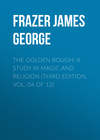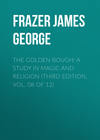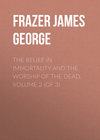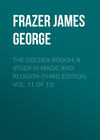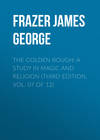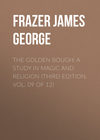Czytaj książkę: «The Golden Bough: A Study in Magic and Religion (Third Edition, Vol. 04 of 12)», strona 2
§ 2. Kings killed when their Strength fails
Divine kings put to death. The Chitomé of Congo. Ethiopian kings of Meroe.
But it is with the death of the god-man – the divine king or priest – that we are here especially concerned. The mystic kings of Fire and Water in Cambodia are not allowed to die a natural death. Hence when one of them is seriously ill and the elders think that he cannot recover, they stab him to death.39 The people of Congo believed, as we have seen,40 that if their pontiff the Chitomé were to die a natural death, the world would perish, and the earth, which he alone sustained by his power and merit, would immediately be annihilated. Accordingly when he fell ill and seemed likely to die, the man who was destined to be his successor entered the pontiff's house with a rope or a club and strangled or clubbed him to death.41 A fuller account of this custom is given by an old Italian writer as follows: “Let us pass to the death of the magicians, who often die a violent death, and that for the most part voluntarily. I shall speak only of the head of this crew, from whom his followers take example. He is called Ganga Chitome, being reputed god of the earth. The first-fruits of all the crops are offered to him as his due, because they are thought to be produced by his power, and not by nature at the bidding of the Most High God. This power he boasts he can impart to others, when and to whom he pleases. He asserts that his body cannot die a natural death, and therefore when he knows he is near the end of his days, whether it is brought about by sickness or age, or whether he is deluded by the demon, he calls one of his disciples to whom he wishes to communicate his power, in order that he may succeed him. And having made him tie a noose to his neck he commands him to strangle him, or to knock him on the head with a great cudgel and kill him. His disciple obeys and sends him a martyr to the devil, to suffer torments with Lucifer in the flames for ever. This tragedy is enacted in public, in order that his successor may be manifested, who hath the power of fertilising the earth, the power having been imparted to him by the deceased; otherwise, so they say, the earth would remain barren, and the world would perish. Oh too great foolishness and palpable blindness of the gentiles, to enlighten the eye of whose mind there would be needed the very hand of Christ whereby he opened the bodily eyes of him that had been born blind! I know that in my time one of these magicians was cast into the sea, another into a river, a mother put to death with her son, and many more seized by our orders and banished.”42 The Ethiopian kings of Meroe were worshipped as gods; but whenever the priests chose, they sent a messenger to the king, ordering him to die, and alleging an oracle of the gods as their authority for the command. This command the kings always obeyed down to the reign of Ergamenes, a contemporary of Ptolemy II., King of Egypt. Having received a Greek education which emancipated him from the superstitions of his countrymen, Ergamenes ventured to disregard the command of the priests, and, entering the Golden Temple with a body of soldiers, put the priests to the sword.43
Kings of Fazoql on the Blue Nile.
Customs of the same sort appear to have prevailed in this region down to modern times. Thus we are told that in Fazoql, a district in the valley of the Blue Nile, to the west of Abyssinia, it was customary, as late as the middle of the nineteenth century, to hang a king who was no longer beloved. His relatives and ministers assembled round him, and announced that as he no longer pleased the men, the women, the asses, the oxen, and the fowls of the country, it was better he should die. Once on a time, when a king was unwilling to take the hint, his own wife and mother urged him so strongly not to disgrace himself by disregarding the custom, that he submitted to his fate and was strung up in the usual way. In some tribes of Fazoql the king had to administer justice daily under a certain tree. If from sickness or any other cause he was unable to discharge this duty for three whole days, he was hanged on the tree in a noose, which contained two razors so arranged that when the noose was drawn tight by the weight of the king's body they cut his throat.44 At Fazolglou an annual festival, which partook of the nature of a Saturnalia, was preceded by a formal trial of the king in front of his house. The judges were the chief men of the country. The king sat on his royal stool during the trial, surrounded by armed men, who were ready to carry out a sentence of death. A little way off a jackal and a dog were tied to a post. The conduct of the king during his year of office was discussed, complaints were heard, and if the verdict was unfavourable, the king was executed and his successor chosen from among the members of his family. But if the monarch was acquitted, the people at once paid their homage to him afresh, and the dog or the jackal was killed in his stead. This custom lasted down to the year 1837 or 1838, when king Yassin was thus condemned and executed.45 His nephew Assusa was compelled under threats of death to succeed him in the office.46 Afterwards it would seem that the death of the dog was regularly accepted as a substitute for the death of the king. At least this may be inferred from a later account of the Fazoql practice, which runs thus: “The meaning of another of their customs is quite obscure. At a certain time of the year they have a kind of carnival, where every one does what he likes best. Four ministers of the king then bear him on an anqareb out of his house to an open space of ground; a dog is fastened by a long cord to one of the feet of the anqareb. The whole population collects round the place, streaming in on every side. They then throw darts and stones at the dog, till he is killed, after which the king is again borne into his house.”47
Shilluk custom of putting divine kings to death. The Shilluk kings supposed to be reincarnations of Nyakang, the semi-divine founder of the dynasty. The shrines of Nyakang.
A custom of putting their divine kings to death at the first symptoms of infirmity or old age prevailed until lately, if indeed it is even now extinct and not merely dormant, among the Shilluk of the White Nile, and in recent years it has been carefully investigated by Dr. C. G. Seligmann, to whose researches I am indebted for the following detailed information on the subject.48 The Shilluk are a tribe or nation who inhabit a long narrow fringe of territory on the western bank of the White Nile from Kaka in the north to Lake No in the south, as well as a strip on the eastern bank of the river, which stretches from Fashoda to Taufikia and for some thirty-five miles up the Sobat River. The country of the Shilluk is almost entirely in grass, hence the principal wealth of the people consists in their flocks and herds, but they also grow a considerable quantity of the species of millet which is known as durra. But though the Shilluk are mainly a pastoral people, they are not nomadic, but live in many settled villages. The tribe at present numbers about forty thousand souls, and is governed by a single king (ret), whose residence is at Fashoda. His subjects take great care of him, and hold him in much honour. In the old days his word was law and he was not suffered to go forth to battle. At the present day he still keeps up considerable state and exercises much authority; his decisions on all matters brought before him are readily obeyed; and he never moves without a bodyguard of from twelve to twenty men. The reverence which the Shilluk pay to their king appears to arise chiefly from the conviction that he is a reincarnation of the spirit of Nyakang, the semi-divine hero who founded the dynasty and settled the tribe in their present territory, to which he is variously said to have conducted them either from the west or from the south. Tradition has preserved the pedigree of the kings from Nyakang to the present day. The number of kings recorded between Nyakang and the father of the reigning monarch is twenty, distributed over twelve generations; but Dr. Seligmann is of opinion that many more must have reigned, and that the genealogy of the first six or seven kings, as given to him, has been much abbreviated. There seems to be no reason to doubt the historical character of all of them, though myths have gathered like clouds round the persons of Nyakang and his immediate successors. The Shilluk about Kodok (Fashoda) think of Nyakang as having been a man in appearance and physical qualities, though unlike his royal descendants of more recent times he did not die but simply disappeared. His holiness is manifested especially by his relation to Jŭok, the great god of the Shilluk, who created man and is responsible for the order of nature. Jŭok is formless and invisible and like the air he is everywhere at once. He is far above Nyakang and men alike, but he is not worshipped directly, and it is only through the intercession of Nyakang, whose favour the Shilluk secure by means of sacrifices, that Jŭok can be induced to send the needed rain for the cattle and the crops.49 In his character of rain-giver Nyakang is the great benefactor of the Shilluk. Their country, baked by the burning heat of the tropical sun, depends entirely for its fertility on the waters of heaven, for the people do not resort to artificial irrigation. When the rain falls, then the grass sprouts, the millet grows, the cattle thrive, and the people have food to eat. Drought brings famine and death in its train.50 Nyakang is said not only to have brought the Shilluk into their present land, but to have made them into a nation of warriors, divided the country among them, regulated marriage, and made the laws.51 The religion of the Shilluk at the present time consists mainly of the worship paid to this semi-divine hero, the traditionary ancestor of their kings. There seems to be no reason to doubt that the traditions concerning him are substantially correct; in all probability he was simply a man whom the superstition of his fellows in his own and subsequent ages has raised to the rank of a deity.52 No less than ten shrines are dedicated to his worship; the three most famous are at Fashoda, Akurwa, and Fenikang. They consist of one or more huts enclosed by a fence; generally there are several huts within the enclosure, one or more of them being occupied by the guardians of the shrine. These guardians are old men, who not only keep the hallowed spot scrupulously clean, but also act as priests, killing the sacrificial victims which are brought to the shrine, sharing their flesh, and taking the skins for themselves. All the shrines of Nyakang are called graves of Nyakang (kengo Nyakang), though it is well known that nobody is buried there.53 Sacred spears are kept in all of them and are used to slaughter the victims offered in sacrifice at the shrines. The originals of these spears are said to have belonged to Nyakang and his companions, but they have disappeared and been replaced by others.
Annual rain-making ceremony performed at the shrines of Nyakang. Harvest ceremony at the shrines of Nyakang.
Two great ceremonies are annually performed at the shrines of Nyakang: one of them is intended to ensure the fall of rain, the other is celebrated at harvest. At the rain-making ceremony, which is held before the rains at the beginning of the month alabor, a bullock is slain with a sacred spear before the door of the shrine, while the king stands by praying in a loud voice to Nyakang to send down the refreshing showers on the thirsty land. As much of the blood of the victim as possible is collected in a gourd and thrown into the river, perhaps as a rain-charm. This intention of the sacrifice comes out more plainly in a form of the ritual which is said to be observed at Ashop. There the sacrificial bullock is speared high up in the flank, so that the wound is not immediately fatal. Then the wounded animal is allowed and indeed encouraged to walk to and from the river before it sinks down and dies. In the blood that streams from its side on the ground the people may see a symbol of the looked-for rain.54 Care is taken not to break the bones of the animal, and they, like the blood, are thrown into the river. At the annual rain-making ceremony a cow is also dedicated to Nyakang: it is not killed but added to the sacred herd of the shrine. The other great annual ceremony observed at the shrines of Nyakang falls at harvest. When the millet has been reaped, every one brings a portion of the grain to a shrine of Nyakang, where it is ground into flour, which is made into porridge with water fetched from the river. Then some of the porridge is poured out on the threshold of the hut which the spirit of Nyakang is supposed to inhabit; some of it is smeared on the outer walls of the building; and some of it is emptied out on the ground outside. Even before harvest it is customary to bring some of the ripening grain from the fields and to thrust it into the thatch of the huts in the shrines, no doubt in order to secure the blessing of Nyakang on the crops. Sacrifices are also offered at these shrines for the benefit of sick people. A sufferer will bring or send a sheep to the nearest sanctuary, where the guardians will slaughter the animal with a sacred spear and pray for the patient's recovery.
Shilluk kings put to death when they shew signs of ill-health or failing strength.
It is a fundamental article of the Shilluk creed that the spirit of the divine or semi-divine Nyakang is incarnate in the reigning king, who is accordingly himself invested to some extent with the character of a divinity. But while the Shilluk hold their kings in high, indeed religious reverence and take every precaution against their accidental death, nevertheless they cherish “the conviction that the king must not be allowed to become ill or senile, lest with his diminishing vigour the cattle should sicken and fail to bear their increase, the crops should rot in the fields, and man, stricken with disease, should die in ever increasing numbers.”55 To prevent these calamities it used to be the regular custom with the Shilluk to put the king to death whenever he shewed signs of ill-health or failing strength. One of the fatal symptoms of decay was taken to be an incapacity to satisfy the sexual passions of his wives, of whom he has very many, distributed in a large number of houses at Fashoda. When this ominous weakness manifested itself, the wives reported it to the chiefs, who are popularly said to have intimated to the king his doom by spreading a white cloth over his face and knees as he lay slumbering in the heat of the sultry afternoon. Execution soon followed the sentence of death. A hut was specially built for the occasion: the king was led into it and lay down with his head resting on the lap of a nubile virgin: the door of the hut was then walled up; and the couple were left without food, water, or fire to die of hunger and suffocation. This was the old custom, but it was abolished some five generations ago on account of the excessive sufferings of one of the kings who perished in this way. He survived his companion for some days, and in the interval was so distressed by the stench of her putrefying body that he shouted to the people, whom he could hear moving outside, never again to let a king die in this prolonged and exquisite agony. After a time his cries died away into silence; death had released him from his sufferings; but since then the Shilluk have adopted a quicker and more merciful mode of executing their kings. What the exact form of execution has been in later times Dr. Seligmann found it very difficult to ascertain, though with regard to the fact of the execution he tells us that there is not the least doubt. It is said that the chiefs announce his fate to the king, and that afterwards he is strangled in a hut which has been specially built for the occasion.
Shilluk kings formerly liable to be attacked and killed at any time by rival claimants to the throne.
From Dr. Seligmann's enquiries it appears that not only was the Shilluk king liable to be killed with due ceremony at the first symptoms of incipient decay, but even while he was yet in the prime of health and strength he might be attacked at any time by a rival and have to defend his crown in a combat to the death. According to the common Shilluk tradition any son of a king had the right thus to fight the king in possession and, if he succeeded in killing him, to reign in his stead. As every king had a large harem and many sons, the number of possible candidates for the throne at any time may well have been not inconsiderable, and the reigning monarch must have carried his life in his hand. But the attack on him could only take place with any prospect of success at night; for during the day the king surrounded himself with his friends and bodyguards, and an aspirant to the throne could hardly hope to cut his way through them and strike home. It was otherwise at night. For then the guards were dismissed and the king was alone in his enclosure with his favourite wives, and there was no man near to defend him except a few herdsmen, whose huts stood a little way off. The hours of darkness were therefore the season of peril for the king. It is said that he used to pass them in constant watchfulness, prowling round his huts fully armed, peering into the blackest shadows, or himself standing silent and alert, like a sentinel on duty, in some dark corner. When at last his rival appeared, the fight would take place in grim silence, broken only by the clash of spears and shields, for it was a point of honour with the king not to call the herdsmen to his assistance.56
When the king did not perish in single combat, but was put to death on the approach of sickness or old age, it became necessary to find a successor for him. Apparently the successor was chosen by the most powerful chiefs from among the princes (niăret), the sons either of the late king or of one of his predecessors. Details as to the mode of election are lacking. So far as Dr. Seligmann could ascertain, the kings elect shewed no reluctance to accept the fatal sovereignty; indeed he was told a story of a man who clamoured to be made king for only one day, saying that he was perfectly ready to be killed after that. The age at which the king was killed would seem to have commonly been between forty and fifty.57 To the improvident and unimaginative savage the prospect of being put to death at the end of a set time, whether long or short, has probably few terrors; and if it has any, we may suspect that they are altogether outweighed in his mind by the opportunities for immediate enjoyment of all kinds which a kingdom affords to his unbridled appetites and passions.
Ceremonies at the accession of a Shilluk king.
An important part of the solemnities attending the accession of a Shilluk king appears to be intended to convey to the new monarch the divine spirit of Nyakang, which has been transmitted from the founder of the dynasty to all his successors on the throne. For this purpose a sacred four-legged stool and a mysterious object which bears the name of Nyakang himself are brought with much solemnity from the shrine of Nyakang at Akurwa to the small village of Kwom near Fashoda, where the king elect and the chiefs await their arrival. The thing called Nyakang is said to be of cylindrical shape, some two or three feet long by six inches broad. The chief of Akurwa informed Dr. Seligmann that the object in question is a rude wooden figure of a man, which was fashioned long ago at the command of Nyakang in person. We may suppose that it represents the divine king himself and that it is, or was formerly, supposed to house his spirit, though the chief of Akurwa denied to Dr. Seligmann that it does so now. Be that as it may, the object plays a prominent part at the installation of a new king. When the men of Akurwa arrive at Kwom with the sacred stool and the image of Nyakang, as we may call it, they engage in a sham fight with the men who are waiting for them with the king elect. The weapons used on both sides are simply stalks of millet. Being victorious in the mock combat, the men of Akurwa escort the king to Fashoda, and some of them enter the shrine of Nyakang with the stool. After a short time they bring the stool forth again and set it on the ground outside of the sacred enclosure. Then the image of Nyakang is placed on the stool; the king elect holds one leg of the stool and an important chief holds another. The king is surrounded by a crowd of princes and nobles, and near him stand two of his paternal aunts and two of his sisters. After that a bullock is killed and its flesh eaten by the men of certain families called ororo, who are said to be descended from the third of the Shilluk kings. Then the Akurwa men carry the image of Nyakang into the shrine, and the ororo men place the king elect on the sacred stool, where he remains seated for some time, apparently till sunset. When he rises, the Akurwa men carry the stool back into the shrine, and the king is escorted to three new huts, where he stays in seclusion for three days. On the fourth night he is conducted quietly, almost stealthily, to his royal residence at Fashoda, and next day he shews himself publicly to his subjects. The three new huts in which he spent the days of his seclusion are then broken up and their fragments cast into the river. The installation of a new king generally takes place about the middle of the dry season; and it is said that the men of Akurwa tarry at Fashoda with the image of Nyakang till about the beginning of the rains. Before they leave Fashoda they sacrifice a bullock, and at every waddy or bed of a stream that they cross they kill a sheep.
Worship of the dead Shilluk kings.
Like Nyakang himself, their founder, each of the Shilluk kings after death is worshipped at a shrine, which is erected over his grave, and the grave of a king is always in the village where he was born.58 The tomb-shrine of a king resembles the shrine of Nyakang, consisting of a few huts enclosed by a fence; one of the huts is built over the king's grave, the others are occupied by the guardians of the shrine. Indeed the shrines of Nyakang and the shrines of the kings are scarcely to be distinguished from each other, and the religious rituals observed at all of them are identical in form and vary only in matters of detail, the variations being due apparently to the far greater sanctity attributed to the shrines of Nyakang. The grave-shrines of the kings are tended by certain old men or women, who correspond to the guardians of the shrines of Nyakang. They are usually widows or old men-servants of the deceased king, and when they die they are succeeded in their office by their descendants. Moreover, cattle are dedicated to the grave-shrines of the kings and sacrifices are offered at them just as at the shrines of Nyakang. Thus when the millet crop threatens to fail or a murrain to break out among the cattle, either Nyakang himself or one of his successors on the throne will appear to somebody in a dream and demand a sacrifice. The dream is reported to the king, who thereupon at once sends a cow and a bullock to one or more of the shrines of Nyakang, if it was he who appeared in the vision, or to the grave-shrine of the particular king whom the dreamer saw in his dream. The bullock is then sacrificed and the cow added to the sacred herd belonging to the shrine. Further, the harvest ceremony which is performed at the shrines of Nyakang is usually, though not necessarily, performed also at the grave-shrines of the kings; and, lastly, sick folk send animals to be sacrificed as offerings on their behalf at the shrines of the kings just as they send them to the shrines of Nyakang.
Sick people and others supposed to be possessed by the spirits of dead Shilluk kings.
Sick people have, indeed, a special reason for sacrificing to the spirits of the dead kings in the hope of recovery, inasmuch as one of the commonest causes of sickness, according to the Shilluk, is the entrance of one of these royal spirits into the body of the sufferer, whose first care, therefore, is to rid himself as quickly as possible of his august but unwelcome guest. Apparently, however, it is only the souls of the early kings who manifest themselves in this disagreeable fashion. Dr. Seligmann met with a woman, for example, who had been ill and who attributed her illness to the spirit of Dag, the second of the Shilluk kings, which had taken possession of her body. But a sacrifice of two sheep had induced the spirit to quit her, and she wore anklets of beads, with pieces of the ears of the sheep strung on them, which she thought would effectually guard her against the danger of being again possessed by the soul of the dead king. Nor is it only in sickness that the souls of dead kings are thought to take possession of the bodies of the living. Certain men and women, who bear the name of ajuago, are believed to be permanently possessed by the spirit of one or other of the early kings, and in virtue of this inspiration they profess to heal the sick and do a brisk trade in amulets. The first symptom of possession may take the form of illness or of a dream from which the sleeper awakes trembling and agitated. A long and complicated ceremony follows to abate the extreme force of the spiritual manifestations in the new medium, for were these to continue in their first intensity he would not dare to approach his women. But whichever of the dead kings may manifest himself to the living, whether in dreams or in the form of bodily possession, his spirit is deemed, at least by many of the Shilluk, to be identical with that of Nyakang; they do not clearly distinguish, if indeed they distinguish at all, between the divine spirit of the founder of the dynasty and its later manifestations in all his royal successors.
The principal element in the religion of the Shilluk is the worship of their kings. The kings put to death in order to preserve their divine spirit from natural decay, which would sympathetically affect the crops, the cattle, and mankind.
In general the principal element in the religion of the Shilluk would seem to be the worship which they pay to their sacred or divine kings, whether dead or alive. These are believed to be animated by a single divine spirit, which has been transmitted from the semi-mythical, but probably in substance historical, founder of the dynasty through all his successors to the present day. Yet the divine spirit, as Dr. Seligmann justly observes, is clearly not thought of as congenital in the members of the royal house; it is only conveyed to each king on his accession by means of the mysterious object called Nyakang, in which, as Dr. Seligmann with great probability conjectures, the holy spirit of Nyakang may be supposed to reside. Hence, regarding their kings as incarnate divinities on whom the welfare of men, of cattle, and of the corn implicitly depends, the Shilluk naturally pay them the greatest respect and take every care of them; and however strange it may seem to us, their custom of putting the divine king to death as soon as he shews signs of ill-health or failing strength springs directly from their profound veneration for him and from their anxiety to preserve him, or rather the divine spirit by which he is animated, in the most perfect state of efficiency: nay, we may go further and say that their practice of regicide is the best proof they can give of the high regard in which they hold their kings. For they believe, as we have seen, that the king's life or spirit is so sympathetically bound up with the prosperity of the whole country, that if he fell ill or grew senile the cattle would sicken and cease to multiply, the crops would rot in the fields, and men would perish of widespread disease. Hence, in their opinion, the only way of averting these calamities is to put the king to death while he is still hale and hearty, in order that the divine spirit which he has inherited from his predecessors may be transmitted in turn by him to his successor while it is still in full vigour and has not yet been impaired by the weakness of disease and old age. In this connexion the particular symptom which is commonly said to seal the king's death-warrant is highly significant; when he can no longer satisfy the passions of his numerous wives, in other words, when he has ceased, whether partially or wholly, to be able to reproduce his kind, it is time for him to die and to make room for a more vigorous successor. Taken along with the other reasons which are alleged for putting the king to death, this one suggests that the fertility of men, of cattle, and of the crops is believed to depend sympathetically on the generative power of the king, so that the complete failure of that power in him would involve a corresponding failure in men, animals, and plants, and would thereby entail at no distant date the entire extinction of all life, whether human, animal, or vegetable. No wonder, that with such a danger before their eyes the Shilluk should be most careful not to let the king die what we should call a natural death of sickness or old age. It is characteristic of their attitude towards the death of the kings that they refrain from speaking of it as death: they do not say that a king has died but simply that he has “gone away” like his divine ancestors Nyakang and Dag, the two first kings of the dynasty, both of whom are reported not to have died but to have disappeared. The similar legends of the mysterious disappearance of early kings in other lands, for example at Rome and in Uganda,59 may well point to a similar custom of putting them to death for the purpose of preserving their life.
